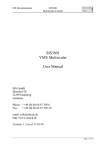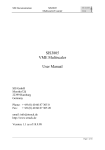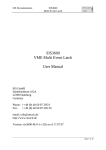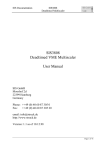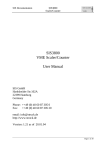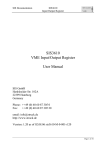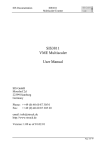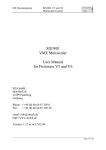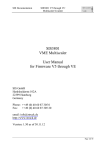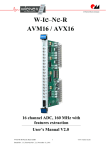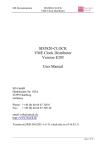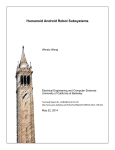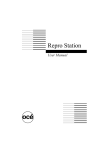Download SIS3803 VME Scaler/Counter User Manual
Transcript
SIS Documentation SIS3803 Scaler/Counter SIS3803 VME Scaler/Counter User Manual SIS GmbH Moorhof 2d 22399 Hamburg Germany Phone: ++49 (0) 40 60 87 305 0 Fax: ++49 (0) 40 60 87 305 20 email: [email protected] http://www.struck.de Version: 1.2 as of 20.12.99 Page 1 of 38 SIS Documentation SIS3803 Scaler/Counter Revision Table: Revision 1.0 1.1 1.2 Page 2 of 38 Date 28.07.98 18.09.98 20.12.99 Modification Generation FIFO flag changes V2/V3 PAL Introduction of revision table Inline front panel design SIS Documentation SIS3803 Scaler/Counter 1 Table of contents 1 2 3 Table of contents...............................................................................................................................................................3 Introduction........................................................................................................................................................................5 Technical Properties/Features.........................................................................................................................................6 3.1 Board Layout.............................................................................................................................................................6 3.2 Counter Design and Modus Operandi...................................................................................................................7 3.3 Count Enable Logic..................................................................................................................................................8 3.4 Clear Logic.................................................................................................................................................................8 4 Getting Started...................................................................................................................................................................9 4.1 Factory Default Settings..........................................................................................................................................9 4.1.1 Adressing..........................................................................................................................................................9 4.1.2 System Reset Behaviour...............................................................................................................................10 5 Firmware Selection .........................................................................................................................................................10 5.1 Examples ..................................................................................................................................................................10 6 Front Panel LEDs ............................................................................................................................................................11 7 VME addressing..............................................................................................................................................................12 7.1 Address Space.........................................................................................................................................................12 7.2 Base Address...........................................................................................................................................................12 7.2.1 VME.................................................................................................................................................................12 7.2.2 VIPA/VME64x...............................................................................................................................................12 7.3 Address Map ...........................................................................................................................................................13 8 Register Description .......................................................................................................................................................14 8.1 Status Register (0x0)..............................................................................................................................................14 8.2 Control Register (0x0)...........................................................................................................................................15 8.3 Module Identification and IRQ control register (0x4)......................................................................................16 8.4 Count disable register 0xC ....................................................................................................................................17 8.5 Overflow registers 0x380, 0x3A0........................................................................................................................17 8.6 Broadcast Addressing............................................................................................................................................17 9 VME Interrupts ...............................................................................................................................................................19 10 Data Format..................................................................................................................................................................20 10.1 D16............................................................................................................................................................................20 10.2 D32............................................................................................................................................................................20 11 Readout Schemes ........................................................................................................................................................20 11.1 Read Shadow Register...........................................................................................................................................20 11.2 Read and Clear all Counters .................................................................................................................................20 11.3 Read Counter...........................................................................................................................................................20 12 Input Configuration ....................................................................................................................................................21 12.1 ECL...........................................................................................................................................................................21 12.2 NIM ...........................................................................................................................................................................22 12.3 TTL............................................................................................................................................................................23 12.3.1 TTL/LEMO.....................................................................................................................................................23 12.3.2 TTL/Flat Cable ...............................................................................................................................................23 13 Connector Specification.............................................................................................................................................23 14 Control Input Modes ..................................................................................................................................................24 15 Signal Specification....................................................................................................................................................25 15.1 Control Signals ........................................................................................................................................................25 15.2 Inputs ........................................................................................................................................................................25 16 Operating Conditions.................................................................................................................................................25 16.1 Power Consumption/Voltage requirement.........................................................................................................25 16.2 Cooling.....................................................................................................................................................................25 16.3 Insertion/Removal...................................................................................................................................................25 17 Test................................................................................................................................................................................26 17.1 LED (selftest)..........................................................................................................................................................26 17.2 Internal pulser tests ................................................................................................................................................26 17.2.1 Single Pulse....................................................................................................................................................26 17.2.2 25 MHz Pulser................................................................................................................................................26 17.3 Reference pulser channel 1 ...................................................................................................................................26 17.4 Signal-Input Priority...............................................................................................................................................26 Page 3 of 38 SIS Documentation 18 SIS3803 Scaler/Counter Software Support ........................................................................................................................................................27 Contents of the included Floppy..........................................................................................................................27 19 Appendix......................................................................................................................................................................28 19.1 Address Modifier Overview..................................................................................................................................28 19.2 Front Panel Layout.................................................................................................................................................29 19.3 List of Jumpers........................................................................................................................................................30 19.4 Jumper and rotary switch locations.....................................................................................................................30 19.4.1 Addressing mode and base address selection...........................................................................................30 19.4.2 J500 (Bootfile Selection) and J520 (SYSRESET Behaviour)...............................................................31 19.5 Board Layout...........................................................................................................................................................32 19.5.1 ECL and two row LEMO version...............................................................................................................32 19.5.2 Inline LEMO version....................................................................................................................................33 19.6 FLASHPROM Versions........................................................................................................................................34 19.7 Row d and z Pin Assignments ..............................................................................................................................35 19.8 Geographical Address Pin Assignments ............................................................................................................36 19.9 Additional Information on VME..........................................................................................................................36 20 Index..............................................................................................................................................................................37 18.1 Page 4 of 38 SIS Documentation SIS3803 Scaler/Counter 2 Introduction The SIS3803 is one of the classic VME counter/scaler implementations on the base of the SIS360x/38xx printed circuit board. The unit has 16 counter channels and a maximum counting frequency of 200 MHz (ECL and NIM) 100 MHz (TTL) respective. As all boards of the family it is of single slot double Eurocard form factor and available with flat cable connectors for ECL and TLL levels and LEMO connectors for NIM and TTL levels. The SIS360x/38xx card is a flexible concept to implement a variety of latch and counter firmware designs. The flexibility is based on two to six Xilinx FPGAs in conjunction with a FLASHPROM from which the firmware files are loaded into the FPGAs. Depending on the stuffing options of the printed circuit board, the user has the possibility to cover several purposes with the same card, hence the manual is a combination of firmware and hardware description . All cards of the family are equipped with the 5 row VME64x VME connectors, a side cover and EMC front panel, as well as the VIPA LED set. For users with VME64xP subracks VIPA extractor handles can be installed. The base board is prepared for VIPA style addressing, the current first version of the SIS3803 firmware does not feature VIPA modes yet however. As we are aware, that no manual is perfect, we appreciate your feedback and will try to incorporate proposed changes and corrections as quickly as possible. The most recent version of this manual can be obtained by email from [email protected], the revision dates are online under http://www.struck.de/manuals.htm. A list of available firmware designs can be retrieved from http://www.struck.de/sis3638firm.htm Page 5 of 38 SIS Documentation SIS3803 Scaler/Counter 3 Technical Properties/Features The SIS3803 is rather a firmware design in combination with given board stuffing options, than a name for the board (this is the reason, why the modules are named SIS360x/38xx on the front panel and the distinction of the units is made by the module identifier register). The firmware makes use of part of the possibilites of the SIS360x/38xx PCB, if the SIS3803 or other firmware designs of the family come close to what you need, but something is missing, a custom firmware design may be an option to consider. Find below a list of key features of the SIS3803. • 16 channels • 200 MHz counting rate (ECL and NIM), 100 MHz for TTL • 32-bit channel depth • NIM/TTL/ECL versions • flat cable (TTL/ECL) and LEMO (TTL/NIM) versions • Shadow register • Read on the fly • A16/A24/A32 D16/D32/BLT32 (CBLT32 prepared) • Base address settable via 5 rotary switches (A32-A12) and one jumper (A11) • VME interrupt capability • VIPA geographical addressing prepared • VIPA LED set • Reference Pulser Capability • Up to eight firmware files • single supply (+5 V) 3.1 Board Layout Xilinx FPGAs are the working horses of the SIS360x/38xx board series. The counter (prescaler, latch, ...) logic is implemented in one to four chips, each chip handles eight front end channels. The VME interface and the input and output control logic reside in two Xilinx chips also. The actual firmware is loaded into the FPGAs upon power up from a FLASHPROM under jumper control. The user can select among up to eight different boot files by the means of a 3-bit jumper array. The counter and control inputs can be factory configured for ECL, NIM and TTL levels, on the control outputs the same levels are the available as options. The standard SIS3803 design has no outputs implemented. The front panel is available as flat cable (ECL and TTL) or LEMO (NIM and TTL) version. The board layout is illustrated with the block diagram below: Page 6 of 38 4 4 4 4 4 4 SIS3803 Scaler/Counter Level Adaption Driver/Receiver Level Adaption Driver/Receiver Control XILINX VME Interface XILINX Level Adaption Driver/Receiver Level Adaption Driver/Receiver Level Adaption Driver/Receiver Level Adaption Driver/Receiver Counter XILINX FLASH PROM Counter XILINX File Selection VME Bus SIS Documentation SIS3803 Block Diagram 3.2 Counter Design and Modus Operandi The counters are implemented in XILINX FPGAs. One of the counter FPGAs holds 8 32-bit deep counter channels. The actual scaler contents are passed to the VME bus via a shadow register. The scaler data have to be copied into the shadow register before readout via a software command or a front panel hardware pulse. This can take place in parallel to the acquisition of counts, what is called read on the fly. On a read on the fly the status of the lowest 6 bits may be not accurate, i.e. the counter readout value is accurate modulo 64. (read on the fly readout accuracy down to one count can be achieved with the SIS3801 multiscaler). No pulses are missed during a read on the fly, i.e. the frontend continues counting. A diagram of the setup is shown in the figure below. The different readout schemes are addressed in the key register section. Input Scaler Channel Latch External Control Shadow Register Clock Shadow Clock Shadow VME Clock Shadow VME Interface VME Bus Page 7 of 38 SIS Documentation SIS3803 Scaler/Counter 3.3 Count Enable Logic A channel acquires input or test counts, if the selective count enable and the global count enable conditions are true. Via the test enable toggle bits in the control register the input of the counter is switched to test pulses or front panel signals. AND Count Enable Selective Disable Enable Scaler Scaler Channel N Control Input Disable MUX 25 MHz reference (channel 1 only) MUX Input N 25 MHz test pulses Single Test Pulse OR External Test Pulse 3.4 Clear Logic The contents of the counters can be cleared via VME access or a front panel pulse. The four possible clear sources are ored as shown in the diagram below. OR Scaler Channel N External Clear Clear VME Selective Clear Channel N VME Clear All Clear after VME read Page 8 of 38 SIS Documentation SIS3803 Scaler/Counter 4 Getting Started The minimum setup to operate the SIS3803 requires the following steps: • Check the proper firmware design is selected (should be design zero, i.e. all jumpers of jumper array J500 set. • Select the VME base address for the desired addressing mode • Select the VME SYSRESET behaviour via J520 • turn the VME crate power off • install the scaler in the VME crate • connect your signals to the counter • turn crate power back on • set global count enable via key address 0x28 • read all counters with clock shadow register via block transfer from start address 0x280 (read) or 0x300 (read and clear) or subsequent single word reads. A good way of checking first time communication with the SIS3803 consists of switching on the user LED by a write to the control register at offset address 0x0 with data word 0x1 (the LED can be switched back off by writing 0x1000 to the control register).. 4.1 Factory Default Settings 4.1.1 Adressing SIS3803 boards are shipped with the En_A32, the En_A24 and the En_A16 jumpers installed and the rotary switches set to: Switch Setting SW_A32U 3 SW_A32L SW_A24U 8 3 SW_A24L 8 SW_A16 3 J A_11 8 Bits 7-4 0 Bits 3-0 0 Jumper A_11 is open (bit 11 set). Hence the unit will respond to the following base addresses: Mode A32 A24 A16 Base address 0x38383800 0x383800 0x3800 Firmware Design Design 1 of the FLASHPROM is selected (lowest jumper of jumper array J500 open, the others set). 4.1.2 System Reset Behaviour J520 is set, i.e. the SIS3803 is reset upon VME reset. 5 Firmware Selection The FLASH PROM of a SIS360x/38xx board can contain several boot files. A list of available FLASHPROM versions can be found on our web site http://www.struck.de in the manuals page. If your FLASHPROM has more than one firmware design, you can select the Page 9 of 38 SIS Documentation SIS3803 Scaler/Counter desired firmware via the firmware selection jumper array J500 . You have to make sure, that the input/output configuration and FIFO configuration of your board are in compliance with the requirements of the selected firmware design (a base board without FIFO can not be operated as multi channel scaler e.g.). A total of 8 boot files from the FLASHPROM can be selected via the three bits of the jumper array. The array is located towards the rear of the card between the VME P1 and P2 connectors. The lowest bit sits towards the bottom of the card, a closed jumper represents a zero, an open jumper a one. 5.1 Examples The figures below show jumper array 500 with the soldering side of the board facing the user and the VME connectors pointing to the right hand side. Bootfile 0 selected With all jumpers closed boot file 0 is selected Bootfile 3 selected With the lowest two jumpers open bit 0 and bit 1 are set to 1 and hence boot file 3 is selected Page 10 of 38 SIS Documentation SIS3803 Scaler/Counter 6 Front Panel LEDs The SIS3803 has 8 front panel LEDs to visualise part of the units status. Three LEDs according to the VME64xP standard (Power, Access and Ready) plus 5 additional LEDs (VME user LED, Clear, Overflow, Scaler enable and VIPA user LED). Designation A P R U CLR OVL S VU LED Access Power Ready VME user LED Clear Overflow Scaler Enable VIPA user LED Color yellow red green green yellow red green green Function Signals VME access to the unit Flags presence of VME power Signals configured logic To be switched on/off under user program control Signals soft or hardware clear Signals Overlow in one or more channels Signals one or more enabled channels for future use The LED locations are shown in the portion of the front panel drawing below. The VME Access, the Clear and the Scaler enable LED are monostable (i.e. the duration of the on phase is stretched for better visibility), the other LEDs reflect the current status. An LED test cycle is performed upon power up (refer to the chapter 17.1). Page 11 of 38 SIS Documentation SIS3803 Scaler/Counter 7 VME addressing 7.1 Address Space As bit 11 is the lowest settable bit on the 360x/38xx board, an address space of 2 Kbytes (Offset plus 0x000 to 0x7ff) is occupied by the module. 7.2 Base Address 7.2.1 VME The VME addressing mode (A16/A24/A32) is selected via the jumpers EN_A16, EN_A24 and EN_A32.The mode is selected by closing the corresponding jumper, it is possible to enable two or all three addressing modes simultaneously. The base address is set via the five rotary switches SW_A32U, SW_A32L, SW_A24U, SW_A24L and SW_A16 and the jumper J_A11. The table below lists the switches and jumpers and their corresponding address bits. Switch/Jumper SW_A32U SW_A32L SW_A24U SW_A24L SW_A16 J_A11 Affected Bits 31-28 27-24 23-20 19-16 15-12 11 In the table below you can see, which jumpers and switches are used for address decoding in the three different addressing modes (fields marked with an x are used). A32 A24 A16 SW_A32U x SW_A32L x SW_A24U x x SW_A24L x x SW_A16 x x x J_A11 x x x Note: J_A11 closed represents a 0, J_A11 open a one 7.2.2 VIPA/VME64x As the VME64x and the VME64xP (VIPA) standard are not yet standards to refer to and to declare conformity with, addressing modes (like geographical addressing e.g.) according to these standards are prepared but not yet implemented in the current firmware revisions. Page 12 of 38 SIS Documentation SIS3803 Scaler/Counter 7.3 Address Map The SIS360x/38xx boards are operated via VME registers, VME key addresses and the FIFO (where installed). The following table gives an overview on all SIS3803 addresses and their offset from the base address, a closer description of the registers and their function is given in the following subsections. Offset 0x000 0x004 0x00C 0x020 0x024 0x028 0x02C 0x030 0x034 0x038 0x03C 0x040 0x044 0x050 0x054 0x060 0x068 0x1000x13C 0x1800x1BC 0x2000x23C 0x2800x2BC 0x3000x33C 0x380 0x3A0 Key KA KA KA KA KA KA KA KA KA KA KA KA KA KA KA Access R/W R/W W W W W W W W W W W W W W W W W Type D16/D32 D16/D32 D16/D32 D16/D32 D16/D32 D16/D32 D16/D32 D16/D32 D16/D32 D16/D32 D16/D32 D16/D32 D16/D32 D16/D32 D16/D32 D16/D32 D16/D32 D16/D32 Function Control and Status register Module Identification and IRQ control register Selective count disable register clear all counters and overflow bits clock shadow register global count enable global count disable Broadcast; clear all counters and overflow bits Broadcast; clock shadow register Broadcast; global count enable Broadcast; global count disable clear counter group and overflow channel 1-8 clear counter group and overflow channel 9-16 enable reference pulser channel 1 disable reference pulser chanel 1 reset register (global reset) Test pulse (generate a single pulse) clear counter N and its overflow bit KA W D16/D32 clear overflow bit of counter N R D16/D32/ BLT32 D16/D32/ BLT32 D16/D32/ BLT32 D16/D32 D16/D32 read shadow register (does not initiate clock shadow) R R R R read counter (initiates clock shadow also) read and clear all counters Overflow register channel 1-8 Overflow register channel 9-16 Note: D08 is not supported by the SIS38xx boards Page 13 of 38 SIS Documentation SIS3803 Scaler/Counter 8 Register Description 8.1 Status Register (0x0) The status register reflects the current settings of most of the SIS3803 parameters in read access, in write access it functions as the control register. Bit 31 30 29 28 27 26 25 24 23 22 21 20 19 18 17 16 15 14 13 12 11 10 9 8 7 6 5 4 3 2 1 0 Function 0 Status VME IRQ source 2 (test IRQ) Status VME IRQ source 1 (ext. clock shadow) Status VME IRQ source 0 (Overflow) VME IRQ internal VME IRQ 0 0 0 Status VME IRQ Enable Bit Source 2 Status VME IRQ Enable Bit Source 1 Status VME IRQ Enable Bit Source 0 0 0 0 reserved (read back as 0 at power up) Global Count Enable General Overflow Bit Status enable reference pulser channel 1 0 0 0 0 0 Status broadcast mode handshake controller Status broadcast mode Status input test mode Status 25 MHz test pulses Status input mode bit 1 Status input mode bit 0 Status IRQ source 2 for software IRQ testing Status user LED The reading of the status register after power up or key reset is 0x0 (see default settings of control register). Page 14 of 38 SIS Documentation SIS3803 Scaler/Counter 8.2 Control Register (0x0) The control register is in charge of the control of most of the basic properties of the SIS3803 board in write access. It is implemented via a selective J/K register, a specific function is enabled by writing a 1 into the set/enable bit, the function is disabled by writing a 1 into the clear/disable bit (which has a different location within the register). An undefined toggle status will result from setting both the enable and disable bits for a specific function at the same time. On read access the same register represents the status register. Bit 31 30 29 28 27 26 25 24 23 22 21 20 19 18 17 16 15 14 13 12 11 10 9 8 7 6 5 4 3 2 1 0 Function reserved disable IRQ source 2 (*) disable IRQ source 1 (*) disable IRQ source 0 (*) reserved reserved reserved clear reserved bit reserved enable IRQ source 2 enable IRQ source 1 enable IRQ source 0 reserved reserved reserved set reserved bit disable broadcast mode handshale controller (*) disable broadcast mode (*) disable input test mode (*) disable 25 MHz test pulses (*) clear input mode bit 1 (*) clear input mode bit 0 (*) clear IRQ test source 2 switch off user LED (*) enable handshake controller for broadcast mode enable broadcast mode enable input test mode enable 25 MHz test pulses set input mode bit 1 set input mode bit 0 set IRQ test (source 2) switch on user LED (*) denotes the default power up or key reset state Page 15 of 38 SIS Documentation SIS3803 Scaler/Counter 8.3 Module Identification and IRQ control register (0x4) This register has two basic functions. The first is to give information on the active firmware design. This function is implemented via the read only upper 20 bits of the register. Bits 1631 hold the four digits of the SIS module number (like 3803 or 3600 e.g.), bits 12-15 hold the version number. The version number allows a distinction between different implementations of the same module number, the SIS3801 for example has the 24-bit mode with user bits and the straight 32-bit mode as versions. Bit 31 30 29 28 27 26 25 24 23 22 21 20 19 18 17 16 15 14 13 12 11 10 9 8 7 6 5 4 3 2 1 0 Read/Write access read only read only read only read only Read only read only read only read only read only read only read only read only read only read only read only read only read only read only read only read only read/write read/write read/write read/write read/write read/write read/write read/write read/write read/write read/write read/write Function Module Identification Bit 15 Module Identification Bit 14 Module Id Digit 3 Module Identification Bit 13 Module Identification Bit 12 Module Identification Bit 11 Module Identification Bit 10 Module Id Digit 2 Module Identification Bit 9 Module Identification Bit 8 Module Identification Bit 7 Module Identification Bit 6 Module Id Digit 1 Module Identification Bit 5 Module Identification Bit 4 Module Identification Bit 3 Module Identification Bit 2 Module Id Digit 0 Module Identification Bit 1 Module Identification Bit 0 Version Bit 3 Version Bit 2 Version Bit 1 Version Bit 0 VME IRQ Enable (0=IRQ disabled, 1=IRQ enabled) VME IRQ Level Bit 2 VME IRQ Level Bit 1 VME IRQ Level Bit 0 IRQ Vector Bit 7; placed on D7 during VME IRQ ACK cycle IRQ Vector Bit 6; placed on D6 during VME IRQ ACK cycle IRQ Vector Bit 5; placed on D5 during VME IRQ ACK cycle IRQ Vector Bit 4; placed on D4 during VME IRQ ACK cycle IRQ Vector Bit 3; placed on D3 during VME IRQ ACK cycle IRQ Vector Bit 2; placed on D2 during VME IRQ ACK cycle IRQ Vector Bit 1; placed on D1 during VME IRQ ACK cycle IRQ Vector Bit 0; placed on D0 during VME IRQ ACK cycle The second function of the register is interrupt control. The interrupter type of the SIS3803 is D08(O) . Via bits 0-7 of the module identifier and interrupt control register you can define the interrupt vector, which is placed on the VME bus during the interrupt acknowledge cycle. Bits 8 through 10 define the VME interrupt level, bit 11 is used to enable (bit set to 1) or disable (bit set to 0) interrupting. Module identification and version example: The register for a SIS3801 in straight 32-bit mode (version 1) reads 0x38011nnn, for a SIS3801 in 24-bit mode (version 2) it reads 0x38012nnn. (the status of the lower 3 nibbles is denoted with n in the example). Page 16 of 38 SIS Documentation SIS3803 Scaler/Counter 8.4 Count disable register 0xC The count disable register can be used to disable single channels or arbitrary groups of channels. Note, that both the external (if used) and the internal conditions have to be in status enable for the given channel. The register is write only. If bit N of the register is set, channel N+1 is disabled. Example: If 0x5 is written to the count disable register, counting of channel 1 and 3 is disabled. 8.5 Overflow registers 0x380, 0x3A0 Each overflow register holds the overflow bit of eight counter channels (i.e. of one counter XILINX) in its highest eight bits. Example: register 0x380 holds the overflow bits of channels 1-8 as shown in the table below. Bit 31 Ch 8 30 Ch 7 29 Ch 6 28 Ch 5 27 Ch 4 26 Ch 3 25 Ch 2 24 Ch 1 Bits 23-1 undefined 8.6 Broadcast Addressing Broadcast addressing is an efficient way to issue the same command to a number of modules. It can be used in A24 and A32 mode on SIS360x/38xx boards. The higher address bits are used to define the broadcast class, the distinction of the modules is done via the A16 rotary switch and the A_11 jumper. If broadcast addressing is used, the A32_U, the A_32_L, the A24_U and the A24_L rotary switches must have the same setting in A32 mode, in A24 mode the A24_U and A24_L setting must be the same on all participating units. One of the participating units must be configured as broadcast handshake controller by setting bit 7 in the units control register. All of the participating units must have set bit 6 (enable broadcast) in the control register. The broadcast time jitter was measured to be less than 40 ns within a VME crate, i.e. you have the possibility issue commands under software control with a maximum uncertainty of 40 ns (like clear all counters), what sure is worse, than a hard wired front panel clear, but is much better than a VME single cycle loop over a number of units. The four broadcast commands are executed via the VME key addresses at offset 0x030 through 0x3C. A32 Broadcast Example: Let four SIS3803 participate by setting the A_32 jumper and setting the base address of the units to: Unit 1: 0x32001000 Unit 2: 0x32001800 Unit 3: 0x32002000 Unit 4: 0x32002800 Switch on enable broadcast by setting bit 6 in the control register of the four units. Enable broadcast handshake controller on unit 4 by setting bit 7 of its control register. An A232 write to address 0x32000034 will clock the shadow register on units 1 through 4. A24 Broadcast Example: Page 17 of 38 SIS Documentation SIS3803 Scaler/Counter Let three SIS3803 participate by setting the A_24 jumper and setting the base address of the units to: Unit 1: 0x541000 Unit 2: 0x542000 Unit 3: 0x543000 Switch on enable broadcast by setting bit 6 in the control register of the three units. Enable broadcast handshake controller on unit 1 by setting bit 7 of its control register. An A24 write to address 0x540030 will clear the counters on units 1 through 3. Page 18 of 38 SIS Documentation SIS3803 Scaler/Counter 9 VME Interrupts Three VME interrupt sources are implemented in the SIS3803 firmware design: • Overflow • External Latch Shadow Input • Test Interrupt The interrupter is of type D8(O). The interrupt logic is shown below. For VME interrupt generation the corresponding interrupt source has to be enabled by setting the respective bit in the VME control register (disabling is done with the sources J/K bit). Interrupt generation has to be enabled by setting bit 11 in the IRQ and version register. The internal VME interrupt flag can be used to check on an IRQ condition without actually making use of interrupts on the bus. The VME interrupt level (1-7) are defined by bits 8 through 10 and the VME interrupt vector (0-255) by bits 0 through 7 of the VME IRQ and version register. In general an interrupt condition is cleared by disabling the corresponding interrupt, clearing the interrupt condition (i.e. clear overflow) and enabling the IRQ again. Note: In most cases your experiment may not require interrupt driven scaler readout, but the interrupt capability of the SIS3803 provides a way to overcome the problem of missing front panel inputs on most commercial VME CPUs. VME_IRQ_ENABLE Overflow AND Enable 0 ext. Shadow VME IRQ Source 0 Clear AND Source 1 Enable 1 CtrlReg Bit1 Test AND OR INTERNAL_VME_IRQ AND Source 2 Enable 2 Page 19 of 38 SIS Documentation SIS3803 Scaler/Counter 10 Data Format The data format of the actual counter values (read via the shadow register) for D16 and D32 reads is shown in the two tables below. 10.1 D16 first read second read high Byte Data Bits 31-24 Data Bits 15-8 low Byte Data Bits 23-16 Data Bits 7-0 10.2 D32 Data Bits 31-24 Data Bits 23-16 Data Bits 15-8 Data Bits 7-0 11 Readout Schemes Scaler data can be read from different locations. The read location has an impact on the counter behaviour. 11.1 Read Shadow Register In a single cycle or block transfer read from the shadow register (0x200-0x23C) the data from the last transfer to the shadow register are obtained. No automatic clock shadow is initiated, i.e. if the user wants to read the actual scaler values he has to ensure a soft- or hardware clock shadow before the read. 11.2 Read and Clear all Counters In a single cycle or block read from the read and clear all counter registers (0x300-0x33C) the data are transferred into the shadow register, all counters are cleared after the transfer and the shadow data are read. Note: If your CPU does not support block transfer you can ensure synchronicity to 5 ns by reading the first scaler value from 0x300 and the rest from the shadow registers 0x204-0x23C. 11.3 Read Counter The read counter behaves like the read and clear all counters except that the counter values are not cleared after the copy to the shadow register. Page 20 of 38 SIS Documentation SIS3803 Scaler/Counter 12 Input Configuration SIS36/38xx boards are available for NIM, TTL and ECL input levels and in LEMO and flat cable versions. The boards are factory configured for the specified input level and connector type, input termination is installed. 12.1 ECL The 100 Ω input termination can be removed in groups of four channels by removing the corresponding resistor networks. The termination of single control inputs can be disabled with jumpers J101 through J108, an open jumper disables the termination of the corresponding channel. Network RN10 RN20 RN30 RN40 RN110 RN120 Channels 1-4 5-8 9-12 13-16 Control 1-4 Control 5-8 1 K Networks RN11/12 RN21/22 RN31/32 RN41/41 RN111/RN112 RN121/RN122 The schematics of the ECL input circuitry is shown below. GND SIL RN(1)X1 1K SIL RN(1)X0 + 100 + SIL RN(1)X2 1K -5 V Page 21 of 38 SIS Documentation SIS3803 Scaler/Counter 12.2 NIM The 50 Ω input termination can be removed in groups of four channels by removing the corresponding resistor networks. The termination of single control inputs can be disabled with jumpers J101 through J108, an open jumper disables the termination of the corresponding channel. Network U15 (Pins 10 to 6) U15 (Pins 1 to 5) U35 (Pins 10 to 6) U35(Pins 1 to 5) U115 (Pins 10 to 6) U115 (Pins 1 to 5) Channels 1-4 5-8 9-12 13-16 Control 1-4 Control 5-8 The schematics of the NIM input circuitry is shown below. GND 50 + - Ref=-0.35 V Page 22 of 38 SIS Documentation SIS3803 Scaler/Counter 12.3 TTL The TTL input level option is possible with LEMO and flat cable connectors. 12.3.1 TTL/LEMO The (low active) TTL/LEMO input circuitry is sketched below. A high active version can be implemented by replacing the 74F245 with a 74F640 5V 1K 245 12.3.2 TTL/Flat Cable In the flat cable TTL version the positive (right hand side) of the connector is tied to ground. 5V 1K - + 245 13 Connector Specification The four different types of front panel and VME connectors used on the SIS360x and SIS38xx boards are: Connector 160 pin zabcd 20 pin header 34 pin header LEMO Purpose VME P1/P2 Control (flat cable versions) Inputs (flat cable versions) Control and Input (LEMO versions) Part Number Harting 02 01 160 2101 DIN41651 20 Pin (AMP e.g.) DIN41651 34 Pin (AMP e.g.) LEMO ERN.00.250.CTL Page 23 of 38 SIS Documentation SIS3803 Scaler/Counter 14 Control Input Modes The assignment of the control inputs can be controlled via the input mode bits in the control register. The only mode using the control inputs at present is mode 1. Control Input Modes Mode 0 (bit1=0, bit0=0): all control inputs are disabled Mode 1 (bit1=0, bit0=1): input 1 -> disable count all channels input 2 -> clear all channels input 3 -> external clock shadow register input 4 -> external test pulse (max 50 MHz) Mode 2 (bit1=1, bit0=0): all control inputs are disabled Mode 3 (bit1=1, bit0=1): all control inputs are disabled Note: The SIS3803 Inline LEMO version has enough front panel space for three letter input labels. In return there is no possibility to add output functionality in a later firmware revisions due to four omitted control LEMOs. Control Input Modes Mode 1 (bit1=0, bit0=1): Page 24 of 38 INH -> disable count all channels CLR -> clear all channels CLK -> external clock shadow register TST -> external test pulse (max 50 MHz) SIS Documentation SIS3803 Scaler/Counter 15 Signal Specification 15.1 Control Signals The width of the clear and external latch shadow pulse has to be greater or equal 10 ns, an external inhibit has to be present for the period you desire to disable counting. An internal delay of some 15 ns has to be taken into account for all external signals. 15.2 Inputs The SIS3803 is specified for counting rates of 200 MHz for ECL and NIM signals and 100 MHz for the TTL case. Thus the minimum high and low level duration is 2.5 ns (5 ns respective). Signal deterioration over long cables has to be taken into account. 16 Operating Conditions 16.1 Power Consumption/Voltage requirement Although the SIS3803 is prepared for a number of VIPA features, it was decided to use an ob board DC/DC converter to generate the –5 V, which are needed for driver and receiver chips, to allow for the use of the module in all 6U VME environments. The power consumption is counting rate dependent, it varies from the idle value of +5 V 3,3 A to +5 V 4,5 A with all channels counting at 200 MHz(i.e. the power consumption is < 23 W). 16.2 Cooling Forced air flow is required for the operation of the SIS3803 board. 16.3 Insertion/Removal Please note, that the VME standard does not support live insertion (hot swap). Hence crate power has to be turned off for installation and removal of SIS3803 scalers. The leading pins on the SIS3803 VME64x VME connectors and connected on board circuitry are designed for hot swap in conjunction with a VME64x backplane (a VME64x backplane can be recognised by the 5 row VME connectors, while the standard VME backplane has three row connectors only). Page 25 of 38 SIS Documentation SIS3803 Scaler/Counter 17 Test The SIS380x scaler series provides the user with a number of test features, which allow for debugging of the unit as well as for overall system setups. 17.1 LED (selftest) During power up self test and LCA configuration all LEDs except the Ready (R) LED are on. After the initialisation phase is completed, all LEDs except the Ready (R) LED and the Power (P) have to go off. Differing behaviour indicates either a problem with the download of the firmware boot file or one or more LCA and/or the download logic. 17.2 Internal pulser tests 17.2.1 Single Pulse A single pulse into all channels can be generated with a write to the key address 0x68 if test mode is enabled via the control register. In conjunction with the count enable register more complex count patterns, like increment patterns e.g., can be generated before readout. 17.2.2 25 MHz Pulser Simultaneous pulsing at 25 MHz into all channels can be used to test the complete readout chain and internal counter logic of the SIS3803. The feature is activated by enabling input test mode and 25 MHz test pulses via the corresponding bits in the control register. The 25 MHz test pulser gives easy access to your VME CPUs readout timing. By making subsequent reads to the same counter and multiplying the difference in counts with 40 ns you can measure the single word access time. 17.3 Reference pulser channel 1 The reference pulser for channel 1 can be seen rather as a monitoring feature than a test feature. It sets the counting rate of channel 1 to 25 MHz (note, that a simultaneous front panel signal on channel 1 is ignored). 17.4 Signal-Input Priority If the user happens to enable more than one input option (enable test mode, enable reference pulser, scaler enable) at the same time, the priority is as show in the table below: Priority 1 2 3 Feature Test mode Reference Pulser (channel 1 only) Front Panel Inputs Example: If test mode and reference pulser are enabled at the same time, channel one will count test pulses (i.e. will count synchronous with the test pulser). Page 26 of 38 SIS Documentation SIS3803 Scaler/Counter 18 Software Support VME scaler boards are tested at SIS with an OR VP6 VME CPU (Pentium II based) under Windows 95 and a National Instruments CVI user interface. The actual VME C code makes use of the OR Windows 95 DLL, which has straightforward to read and understand routines like: VMEA24StdWriteWord(a32address + KEY_RESET, 0x0); rdata = VMEA24StdReadWord(a32address + STAT_REG); /* Key Reset */ In most cases the user setup will be using different hardware, a full fleshed real time operating system like VxWorks, and a different user interface. We still believe, that it is helpful to have a look at the code which is used to test the units and to take it as an example for the implementation of the actual scaler readout application. A floppy with our test software is enclosed with SIS3803 shipments. Depending on the user feedback and co-operation we expect, that we will have drivers or at least example routines for the commonly used VME CPU operating systems at hand in the mid term. 18.1 Contents of the included Floppy The Floppy contains a readme.txt file with the most up to date information, the CVI project file and all home made files from the project. The important part of the code for the implementation of your own program is sitting in the CVI call back routines. Page 27 of 38 SIS Documentation SIS3803 Scaler/Counter 19 Appendix 19.1 Address Modifier Overview Find below the table of address modifiers, which can be used with the SIS360x/38xx (with the corresponding addressing mode enabled). AM code 0x3F 0x3D 0x3B 0x39 0x2D 0x29 0x0F 0x0D 0x0B 0x09 Page 28 of 38 Mode A24 supervisory block transfer (BLT) A24 supervisory data access A24 non-privileged block transfer (BLT) A24 non-privileged data access A16 supervisory access A16 non-privileged access A32 supervisory block transfer (BLT) A32 supervisory data access A32 non-privileged block transfer (BLT) A32 non privileged data access Future option: CBLT SIS Documentation SIS3803 Scaler/Counter 19.2 Front Panel Layout The front panel of the SIS3803 is equipped with 8 LEDs, 8 control in- and outputs and 16 counter inputs. On flat cable units (ECL and TTL) the control connector is a 20 pin header flat cable connector and the channel inputs are fed via a 34-pin headers. On LEMO (NIM and TTL) units the control in- and outputs are grouped to one 8 channel block and the counter inputs are grouped into one block of 16 channels. The units are 4 TE (one VME slot) wide, the front panel is of EMC shielding type. VIPA extractor handles are available on request or can be retrofitted by the user, if he wants to change to a VIPA crate at a later point in time. In the drawing below you can find the flat cable (left hand side), LEMO (middle) and Inline LEMO (right hand side) front panel layouts. Note: Only the aluminium portion without the extractor handle mounting fixtures is shown TST CLK CLR INH SIS3803 Scaler DATA 16 13 12 9 8 5 4 1 Page 29 of 38 SIS Documentation SIS3803 Scaler/Counter 19.3 List of Jumpers Find below a list of the jumpers and jumper arrays. Jumper Name J101 J102 J103 J104 J105 J106 J107 J108 J115 J500 J520 EN_A16 EN_A24 EN_A32 J_A11 Array/Singl e Single Single Single Single Single Single Single Single Single Array Single Single Single Single Single Function Input Termination Control Input 1 Input Termination Control Input 2 Input Termination Control Input 3 Input Termination Control Input 4 Input Termination Control Input 5 Input Termination Control Input 6 Input Termination Control Input 7 Input Termination Control Input 8 Level Configuration (not for end user) Boot File Selection VME SYSRESET Behaviour Enable A16 addressing Enable A24 addressing Enable A32 addressing Address Bit 11 Selection 19.4 Jumper and rotary switch locations 19.4.1 Addressing mode and base address selection The EN_A32, EN_A24, EN_A16, A_11 and the 5 rotary switches are located int the middle of the upper section of the board close to the DC/DC converter, the corresponding section of the PCB is shown below. Page 30 of 38 SIS Documentation SIS3803 Scaler/Counter 19.4.2 J500 (Bootfile Selection) and J520 (SYSRESET Behaviour) The jumper array J500 is located between the P1 and the P2 connector. An open position in J500 defines a one (see also chapter 4), the lowest bit is next to the P2 connector.. J520 is located to the left of J500 and closer to the DC-DC converter. With jumper J520 closed the SIS3803 executes a key reset upon the VME SYSRESET signal. The section of the board with the jumper array and the SYSRESET jumper is shown below. Page 31 of 38 SIS Documentation SIS3803 Scaler/Counter 19.5 Board Layout 19.5.1 ECL and two row LEMO version Page 32 of 38 SIS Documentation SIS3803 Scaler/Counter 19.5.2 Inline LEMO version Page 33 of 38 SIS Documentation SIS3803 Scaler/Counter 19.6 FLASHPROM Versions A list of available FLASHPROMs can be obtained from http://www.struck.de/sis3638firm.htm. Please note, that a special hardware configuration may be necessary for the firmware design of interest (the SIS3801 design requires the installation of a FIFO e.g.). The table on the web is of the format shown below: SIS36/38xx FLASHPROM table Design Name SIS3800_201098 SIS3801_201098 SIS3803_131198 SIS3803_151298 Page 34 of 38 Design 0 0 1 2 3 0 0 Boot File (s) SIS3800 Version 1 SIS3800 Version 1 SIS3800 Version 2 SIS3801 Version 1 (32-bit Design) SIS3801 Version 2 (24-bit Design) SIS3803 Version 1 SIS3803 Version 1 (Inline) SIS Documentation SIS3803 Scaler/Counter 19.7 Row d and z Pin Assignments The SIS3803 is prepared for the use with VME64x and VME64xP backplanes. Foreseen features include geographical addressing and live insertion (hot swap). The prepared pins on the d and z rows of the P1 and P2 connectors are listed below. Position P1/J1 Row z 1 2 3 4 5 6 7 8 9 10 11 12 13 14 15 16 17 18 19 20 21 22 23 24 25 26 27 28 29 30 31 32 GND P2/J2 Row d VPC (1) GND (1) Row z GND GND GND GND GND GND GND RESP* GND Row d GND GAP* GA0* GA1* GND GND GA2* GND GND GA3* GND GND GA4* GND GND GND GND GND GND GND GND GND GND GND GND GND GND GND GND (1) VPC (1) GND GND (1) VPC (1) Note: Pins designated with (1) are so called MFBL (mate first-break last) pins on the installed 160 pin connectors, VPC(1) pins are connected via inductors. Page 35 of 38 SIS Documentation SIS3803 Scaler/Counter 19.8 Geographical Address Pin Assignments The SIS38xx board series is prepared for geographical addressing via the geographical address pins GA0*, GA1*, GA2*, GA3*, GA4* and GAP*. The address pins are left open or tied to ground by the backplane as listed in the following table: Slot Number 1 2 3 4 5 6 7 8 9 10 11 12 13 14 15 16 17 18 19 20 21 GAP* Pin Open Open GND Open GND GND Open Open GND GND Open GND Open Open GND Open GND GND Open GND Open GA4* Pin Open Open Open Open Open Open Open Open Open Open Open Open Open Open Open GND GND GND GND GND GND GA3* Pin Open Open Open Open Open Open Open GND GND GND GND GND GND GND GND Open Open Open Open Open Open GA2* Pin Open Open Open GND GND GND GND Open Open Open Open GND GND GND GND Open Open Open Open GND GND GA1* Pin Open GND GND Open Open GND GND Open Open GND GND Open Open GND GND Open Open GND GND Open Open GA0* Pin GND Open GND Open GND Open GND Open GND Open GND Open GND Open GND Open GND Open GND Open GND 19.9 Additional Information on VME The VME bus has become a popular platform for many realtime applications over the last decade. Information on VME can be obtained in printed form, via the web or from newsgroups. Among the sources are the VMEbus handbook, http://www.vita.com (the home page of the VME international trade association (VITA)) and comp.bus.arch.vmebus. In addition you will find useful links on many high energy physics labs like CERN or FNAL Page 36 of 38 SIS Documentation SIS3803 Scaler/Counter 20 Index 24-bit mode 17 25 MHz Pulser 26 25 MHz test pulses 15 32-bit mode 17 A_11 9, 30 A16 9 A24 9 A24 Broadcast Example 18 A32 9 A32 Broadcast Example 17 Address Map 13 Address Modifier Overview 28 address modifiers 28 Address Space 12 addressing A16, A24, A32 30 addressing mode 28 Addressing mode 30 addressing modes 12 Adressing 9 Base address 9 Base Address 12, 30 block diagram 6 BLT 28 Board Layout 32 Boot File Selection 30 Bootfile Selection 31 Broadcast Addressing 17 broadcast handshake controller 17 broadcast mode 15 broadcast mode handshake controller 15 broadcast time jitter 17 CBLT 28 CERN 36 Clear Logic 8 Connector Specification 23 control input 30 Input Modes 24 output 24 Register 15 Control and Status register 13 Cooling 25 Count disable register 17 Count Enable 8 custom firmware 6 CVI 27 call back routines 27 project file 27 D08(O) 16 D16 20 D32 20 Data Format 20 DC/DC converter 30 drivers 27 ECL 5, 21 En_A16 9 EN_A16 12, 30 En_A24 9 EN_A24 12, 30 En_A32 9 EN_A32 12, 30 External Latch Shadow Input 19 Factory Default Settings 9 firmware 5 firmware design 9, 16 Firmware Design 9 Firmware Selection 10 Bootfile 10 Examples 10 FLASHPROM 5, 6, 9, 10 FLASHPROM Versions 34 flat cable 5 Floppy 27 FNAL 36 Front Panel LED 11 Front Panel Layout 29 GA0* 36 GA1* 36 GA2* 36 GA3* 36 GA4* 36 GAP* 36 geographical address pins 36 Geographical Address 36 geographical addressing 35 Getting Started 9 hot swap 25, 35 http //www.vita.com 36 inline 24, 29, 33 Input Configuration 21 input mode 15 Input Priority 26 input test mode 15, 26 Insertion/Removal 25 interrupt acknowledge cycle 16 interrupt condition 19 interrupt control 16 interrupt level 16, 19 interrupt logic 19 interrupt vector 16, 19 interrupter type 16 IRQ source 15 J_A11 12, 30 J101-J108 30 J115 30 J500 9, 30, 31 J520 9, 30, 31 jumper firmware selection 10 VME addressing mode 12 Jumper overview 30 Jumper and rotary switch locations 30 key address 13 LED 11 Access 11 Color 11 Power 11 Ready 11 user 9 LEMO 5 live insertion 25, 35 Page 37 of 38 SIS Documentation Module Identification and IRQ control register 16 Module Identification and IRQ Control register 13 module number 16 monostable 11 NIM 5, 22 Operating Conditions 25 OR VP6 27 output control 24 Overflow 19 Overflow registers 17 PCB 6 Pentium II 27 Power Consumption 25 Read and Clear Counter 20 Read Counter 20 read on the fly 7 Read Shadow Register 20 Readout Schemes 20 Reference pulser channel 1 26 register Control and Status 13 count disable 13, 17 Module Identification and IRQ Control 13 shadow 7 rotary switch 30 shadow register 7 Signal Specification 25 Control 25 Inputs 25 Single Pulse 26 SIS360x/38xx 5 Software Support 27 Status Register 14 Page 38 of 38 SIS3803 Scaler/Counter SW_A16 9, 12 SW_A24L 9, 12 SW_A24U 9, 12 SW_A32L 9, 12 SW_A32U 9, 12 SYSRESET Behaviour 31 System Reset 10 Technical Properties/Features 6 Test Interrupt 19 TTL 5, 23 version number 16 VIPA 25 addressing 5 base address 12 extractor handles 5 LED set 5 VITA 36 VME 25, 36 addressing mode 12 Base Address 12 CPU 27 SYSRESET 31 SYSRESET Behaviour 30 VME addressing 12 VME control register 19 VME Interrupts 19 VME IRQ and version register 19 VME64x 12, 35 connector 5 VME64xP 5, 12, 35 Voltage requirement 25 VxWorks 27 Windows 95 27 XILINX 7






































